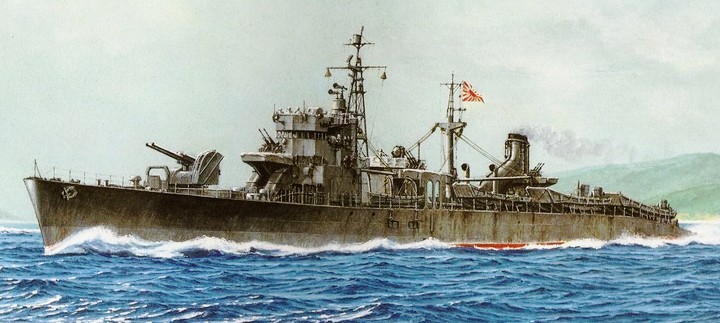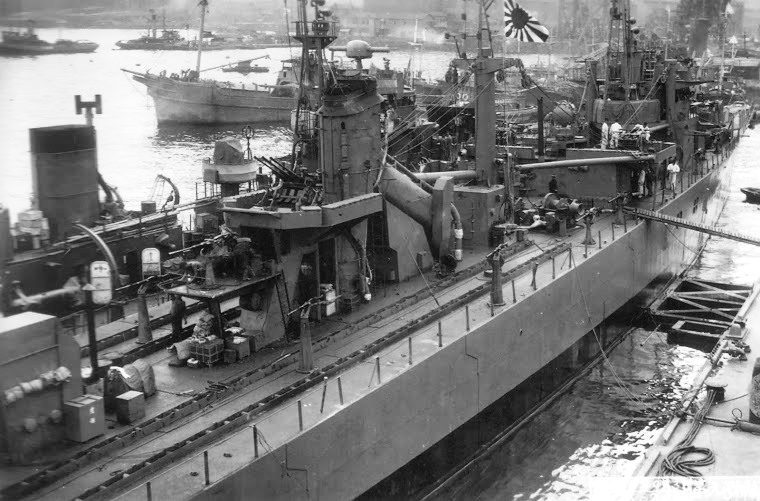Dai 1 Go-gata Yusokan
IJN No. 1 Class Fast Transport
 (No. 1 Class Fast Transport T.5 by T. Yuki)
(No. 1 Class Fast Transport T.5 by T. Yuki)
IJN Transport T.9:
Tabular Record of Movement
© 2014-2018 Bob Hackett and Sander Kingsepp.
Revision 3
28 May 1944:
Kure Naval Arsenal Laid down as Ship No. 2909, a 1,500-ton No.
1 class landing ship.
15 July 1944:
Launched and numbered T.9.
15 August 1944:
Reserve LtCdr Akagi Tsuyoshi is appointed the Chief
Equipping Officer (CEO).
20 September 1944:
Completed. Attached to Sasebo Naval District.
LtCdr Akagi Tsuyoshi is the CO.
 No. 1 Class Fast Transport showing triple, twin
and single 25 mm Type 96 AA guns and single 13 mm Type 93 machine guns.
25 September 1944:
No. 1 Class Fast Transport showing triple, twin
and single 25 mm Type 96 AA guns and single 13 mm Type 93 machine guns.
25 September 1944:
T.9 is administratively assigned to Rear
Admiral Sone Akira's (44)(former CO of NACHI) 1st Transport Squadron. Naval
transports T.6 and T.10, and six T.101-class landing ships are also initially
assigned to TransRon 1.
11 October 1944:
T.9 and T.10 arrive at Kure and Sasebo. Each
embarks two "Hei Gata"
Type C midget submarines (HA-81, HA-82, HA-82 and HA-84).
15 October 1944:
T.9 and T.10 depart Sasebo for Davao via Manila.
20 October 1944: American Operation "KING TWO" - The Invasion of Leyte,
Philippines:
Admiral (later Fleet Admiral) William F. Halsey's (former CO of
SARATOGA, CV-3) Third Fleet of 738 ships including 18 aircraft carriers, six
battleships, 17 cruisers, 64 destroyers and over 600 support ships land the
Army's X Corps (24 th Infantry and 1st Cavalry Divisions) and the XXIV Corps
(7th, 77th and 96th Infantry Divisions) that begins the campaign to retake
Leyte. Following the landing at Leyte, T.9 and T.10 are diverted to Cebu.
October 1944:
T.9 and T.10 arrive at Cebu and unload the four
midget submarines. By 1 November, the Cebu midget submarine base is operational
and supports six midget submarines including Lt Sasakawa Tsutomu's HA-81, HA-82,
WO Kashiwaki Kimihiro's HA-83 and WO Matsuda's HA-84, all landed by T.9 and
T.10.
23 October 1944: Operation "TA" (TA-Go Sakusen) - The Reinforcement of
Leyte:
Vice Admiral Mikawa Gunichi (former CO of KIRISHIMA), CinC,
Southwest Area Fleet, commences "TA" to provide reinforcements, supplies and
munitions to IJA forces engaging the American invasion forces on Leyte. Between
23 October and 11 December 1944, nine major convoys attempt the 600-mile passage
from Manila to Ormoc Bay, Leyte. That same day, T.9 departs Manila for Ormoc
Bay, Leyte with T.6, T.10, T.101 and T.102.
24 October 1944:
In the morning, light cruiser KINU and destroyer
URANAMI sortie from Cavite for Cagayan. CruDiv 16 is attacked by aircraft from
Rear Admiral (later Admiral) Frederick C. Sherman's (former CO of LEXINGTON
(CV-2) Task Group 38.3's carriers USS ESSEX (CV-9) and LEXINGTON (CV-16). Near
misses cause light structural damage, but strafing kills 47 crewmen aboard the
KINU and 25 crewmen on URANAMI.
25 October 1944:
Arrives at Cagayan. T.9, T.6 and T.10 each embark
350 troops and T.101 and T.102 each load 400 men. In the morning, they depart
for Ormoc as CruDiv 16 arrives. KINU embarks 347 men and URANAMI 150 men, then
they depart Cagayan.
26 October 1944:
Visayan Sea, Jintotolo Channel. At 1020, KINU and
URANAMI are attacked by 75-80 aircraft from two groups of Task Group 77.4's
escort carriers. TBM "Avenger" torpedo-bombers from USS NATOMA BAY (CVE-62) and
12 Avengers and FM-2 "Wildcat" fighters of VC-21 from MARCUS ISLAND (CVE-77)
make repeated bomb, rocket and strafing hits on KINU and URANAMI. An Avenger
from MANILA BAY (CVE-61) scores two bomb hits on KINU and several rocket hits on
URANAMI that sinks about noon with 103 crew KIA.
At 1130, two more waves of aircraft attack. A third bomb hits an engine
room aft and sets KINU ablaze. She remains afloat, but unnavigable and begins to
settle by the stern. Naval transports arrive at mid-afternoon. T.9, T.6 and
T.10 rescue most of KINU's crew of 813 men. The transports each take on about
300 survivors. ComCruDiv 16 Rear Admiral (later Vice Admiral) Sakonjo Naomasa
(40)(former CO of SETTSU) transfers his flag to T.10 and it makes Manila the next
day. At 1730, KINU sinks by the stern in 150 feet of water 44 miles SW of
Masbate.
31 October 1944: Operation "TA No. 2" (TA-Go 2-ji Sakusen) - The
Reinforcement of Leyte:
Led by Rear Admiral (later Vice Admiral)(41) Kimura
Masatomi (former CO of SUZUYA), T.9, T.6 and T.10 depart Manila for Ormoc Bay,
carrying 1,000 men of the Imabori Detachment (12th Independent Infantry Regiment).
They endure sporadic air attacks en route without damage.
1 November 1944:
In the afternoon, T.9, T.6 and T.10 land their troops
at Ormoc. T.6 and T.10 then return to Manila. T.9 is detached to Cebu to pick
up General Suzuki and about 100 men of 35th Army headquarters.
2 November 1944:
At dawn, T.9 arrives back at Ormoc. T.9 is dispatched
to assist T.131 that had been strafed by a single B-24 near Panay on 31 October.
3 November 1944:
In the morning, DesDiv 21 is also dispatched to
assist. T.9 take T.131 in tow with DesDiv 21's HATSUHARU and HATSUSHIMO as
escorts.
8 November 1944: Operation "TA No. 4" (TA-Go 4-ji Sakusen) - The
Reinforcement of Leyte:
At 1030, T.9, T.6 and T.10 depart Manila into typhoon
seas accompanied by 1st echelon transports TAKATSU (KOSHIN or KOZU), KINKA and
KASHII MARUs, carrying 10,000 men of the 26th Infantry Division T.9, T.6 and T.10
carry 3,000 men of the 1st Division including 2nd Battalion, the main forces of
the st Infantry Regiment, 3rd Battalion, 49th Infantry Regiment and 1sr Battalion
57th Infantry Regiment. The transports also carry 3,500 tons of munitions.
The transports are escorted by Rear Admiral Matsuyama's kaibokan OKINAWA
and Admiral Kimura's destroyer screen of KASUMI (F), AKISHIMO, ASASHIMO,
NAGANAMI, USHIO and WAKATSUKI and kaibokan CD-11 and CD-13. All proceed under
cover of the storm to Ormoc Bay, Luzon.
9 November 1944:
13th Air Force North American B-25 "Mitchell" medium
bombers and Lockeed P-38 "Lightning" fighter-bombers damage OKINAWA and kaibokan
SHIMUSHU. In the evening, the convoy arrives at Ormoc Bay. Four B-25s and 16
P-38 escorts attack T.9, T.6 and T.10, the first of the transports to arrive.
All three are slightly damaged, but their gunners claim four of their attackers
shot down.
10 November 1944:
N of Cebu. The convoy is attacked by P-38s from
Morotai and B-25s from Leyte. About 1140, during the second attack of the day,
OKINAWA is bracketed by near misses and strafed by B-25 bombers, wounding six
sailors. KASHII MARU is damaged, TAKATSU (KOSHIN or KOZU) MARU blows up after a
bomb hit with the loss of 243 gunners and 104 crewmen and Army's 72nd Specially
Established Machine Cannon Unit with its twelve Type 96 25mms. OKINAWA claims
one B-25. In the same attack, CD-11 is crippled and later scuttled by CD-13.
Unloading proceeds poorly. Of about 50 daihatsu gathered at Ormoc for the
landings, only five remain operational. The rest have either been wrecked or
buried in mudslides by the typhoon, but T.10 brings in six more daihatsu this
trip. Several large rafts are put together and three of kaibokan are pressed
into service shuttling men and munitions between ship and shore. These efforts
succeed in getting all the troops ashore by sunrise, but much material remains
aboard the transports. By mid-morning, T.9, T.6 and T.10, depart Ormoc for
Manila.
5 November 1944:
In the morning, all reach Cavite Naval Yard.
24 November 1944: "Operation TA No. 5" (TA-Go 5-ji Sakusen) - The
Reinforcement of Leyte:
T.9, T.6 and T.10 depart Manila escorted by
destroyer TAKE. T.9 carries the 3rd Company and part of the 1st Machine-gun
Company of 1st Battalion, 12th Independent Infantry Regiment.
25 November 1944:
Arrives at Port Balanacan, Marinduque, Central
Philippines. That same day, aircraft from fast carriers of Task Groups 38.1 and
38.2 attack the convoy and sink T.10 at 13.32N, 121.52E. The planes also sink
T.6 and damage T.9. T-9 lands her troops at Masbate Island, then returns to
Manila in company of TAKE.
9 December 1944: "Operation TA No. 9" (TA-Go 9-ji Sakusen) - The
Reinforcement of Leyte:
Manila. In the afternoon, the ninth and final
"TA" operation gets underway. T.9 departs for Cebu carrying two midget
submarines Later that day, T.9 arrives and delivers Lt Shima Yoshimitsu's
midget submarine HA-69 and Lt(j.g.) Shibuta Kiyoshi's HA-76.
January 1945:
T.9 returns to Sasebo via Hong Kong, carrying supplies.
Later, she transfers to Kure Navy Yard for repairs.
21 February-29 July 1945:
T.9 completes 12 successful transport
missions from Yokosuka to Hachijo Jima and Chichi Jima.
25 April 1945:
Reserve LtCdr Komatsu Takashi (former CO of PB-104)
is appointed the CO.
June 1945:
Soon after departure from Futami harbor, Chichi Jima,
T.9 is attacked by carrier aircraft. A total of 29 sailors are KIA and 70 WIA.
12 August 1945:
T.9 departs Kure transporting
Kairyu midget submarines to Saeki.
15 August 1945: End of Hostilities:
T.9 receives word of Japan's
surrender and returns to Kure.
15 September 1945:
T.9 is decommissioned. Removed from the Navy
List.
17 October 1945:
Lt Yamaki Teiji (68)(former CO of the Ourazaki
Special Attack Unit) is appointed the CO.
E 1946:
Assigned to the Allied Repatriation Service. [1]
26 April 1947:
Ex-Lt Honda Yukito (former CO of T.110) is appointed
the CO of T.9 and T.13 as additional duty.
5 August 1947:
Ex-Lt Nakagaki Yoshiyuki (72)(former navigator of
YUKIKAZE) is appointed the CO.
7 September 1947:
Ex-Captain Taniguchi Toshio (50) is appointed the CO.
1947~1948:
In service as whaling mothership in the North Pacific.
26 June 1948:
Ceded to the United States as a war reparation. [2]
June 1948:
Sold for scrap.
1 October 1948:
Scrapped at Ishikawajima.
Author's Note:
[1] Allied occupation forces were responsible for the return
of six million Japanese military personnel and civilians from Japan's defunct
far-flung Empire. In addition, there were over a million Korean and about 40,000
Chinese prisoners and conscript laborers and approximately 7,000 Formosans and
15,000 Ryukyu Islanders to be repatriated.
Some Allied and many former IJN warships, from aircraft carriers to
kaibokan, were used to facilitate the enormous repatriation effort. Japanese
vessels and crews were used to the fullest extent possible to conserve Allied
manpower and accelerate demobilization. Each ex-IJN ship first had to be
demilitarized; guns removed or, in the case of large warships, barrels severed,
ammunition landed, and radar and catapults removed, if fitted. Repatriation of
the Chinese on Japanese ships began early in October from Hakata, but U.S. guard
detachments had to be placed on many ships to prevent disorder because the
Japanese crews could not control the returnees.
Japanese-run repatriation centers were established at Kagoshima, Hario
near Sasebo, and Hakata near Fukuoka. Other reception centers were established
and operated at Maizuru, Shimonoseki, Sasebo, Senzaki, Kure, Uraga, Yokohama,
Moji and Hakodate. Allied line and medical personnel supervised the centers.
Incoming Japanese were sprayed with DDT, examined and inoculated for typhus and
smallpox, provided with food, and transported to their final destination in
Japan.
[2] A new Gakken Pictorial casts some doubt as to whether T.9 actually
was ceded to the US post-war. Gakken claims she was allowed to be kept by Japan
if scrapped sometime in the future. Active as a whaling mothership, Gakken
indicates she was scrapped once her age and condition prevented further usage.
Thanks go to John Whitman of Virgina and Fontessa-san of Japan for
additional TA No. 4 and TA No. 5 troop info and to Matt Jones foe additional CO
info.
-Bob Hackett
Back
to Fast Transport Page






